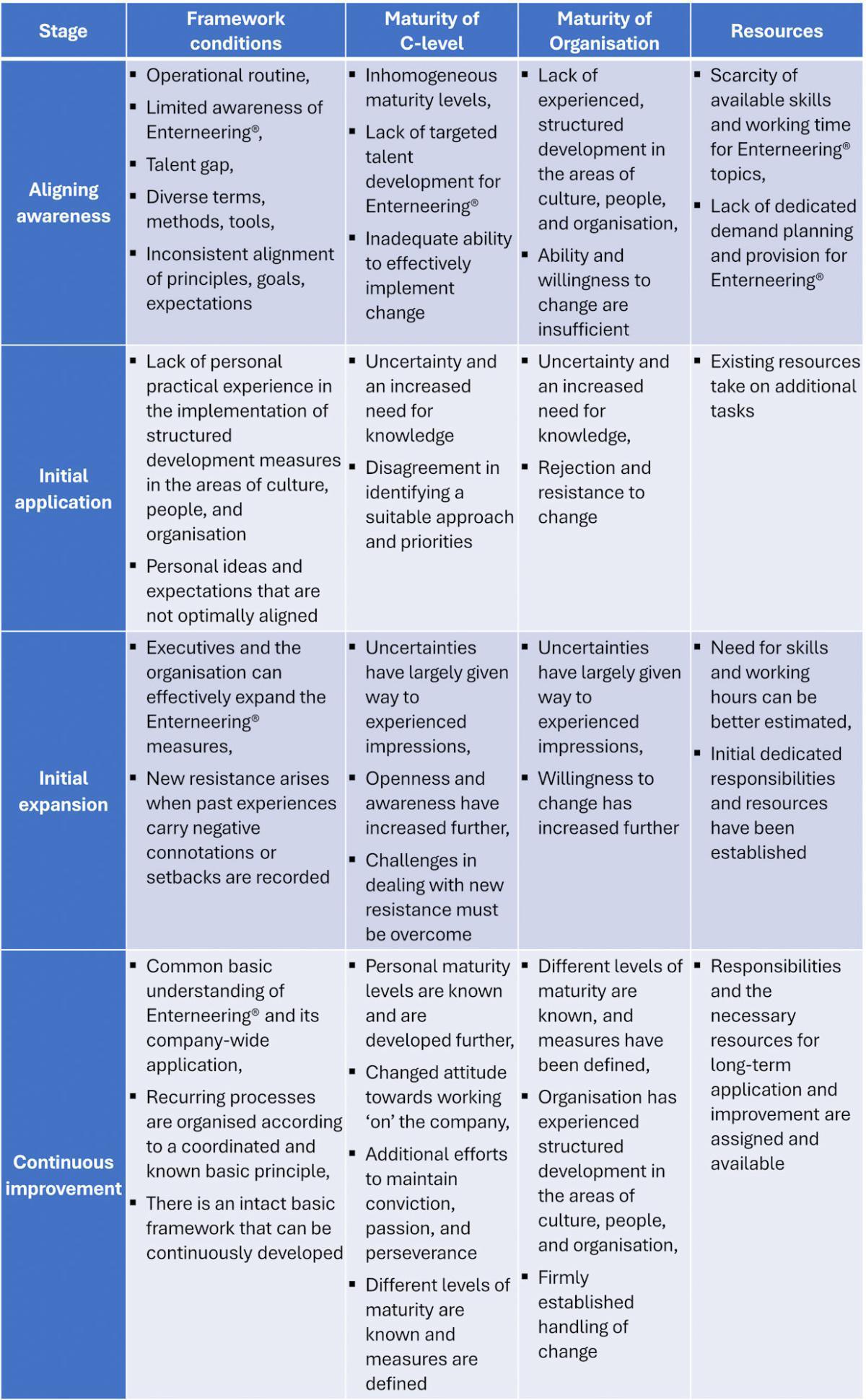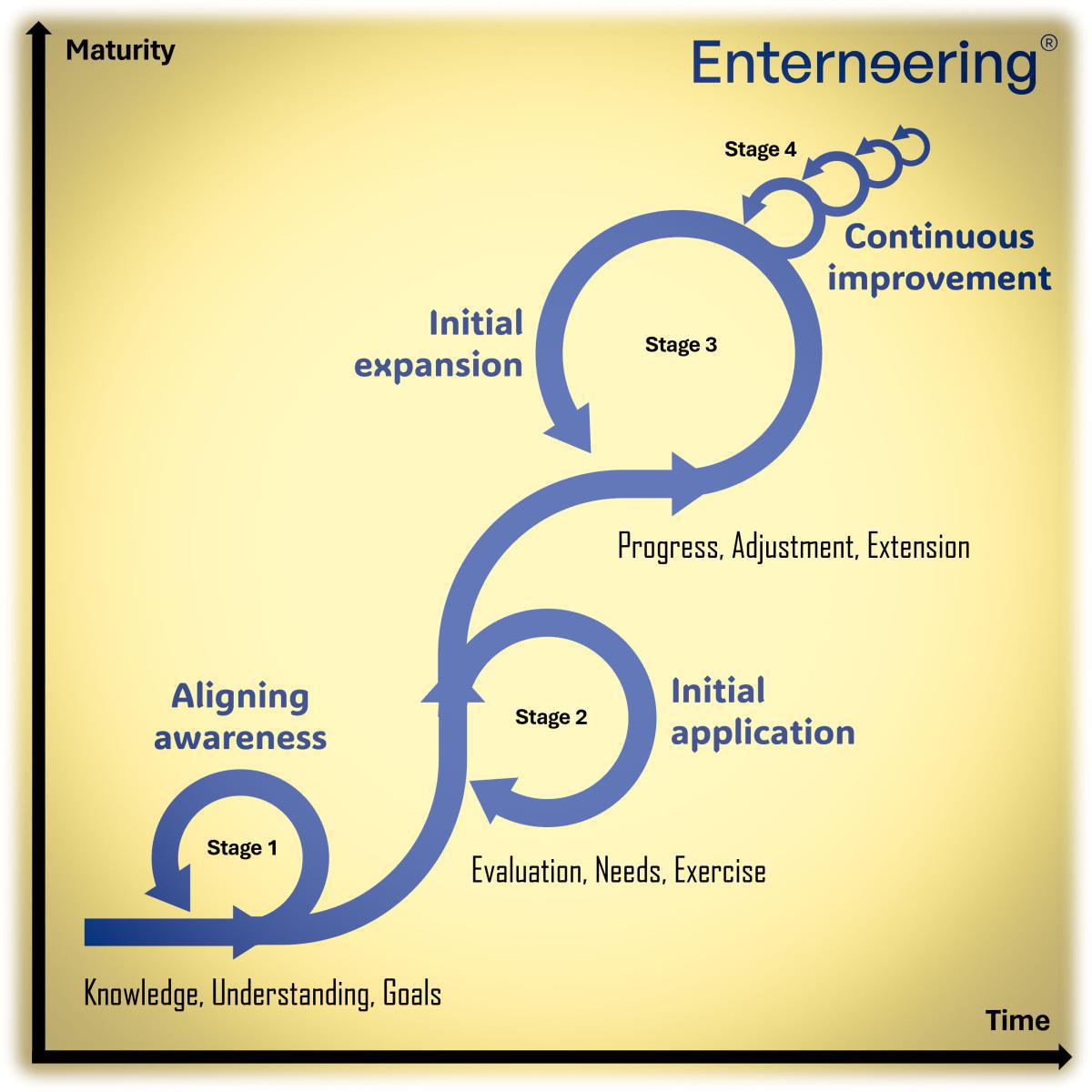Enterneering® does not describe a one-off process, but rather the continuous work of corporate management on the further development and transformation of the company in its core areas of culture, people, and organisation. Nevertheless, four development phases can be methodically derived:
- Aligning awareness: When a company or its management consciously engages with the term Enterneering® and its targeted application for the first time.
- Initial application: Following the first step, when a dedicated practical implementation takes place for the first time.
- Initial expansion: When the topics prioritised in the initial application are supplemented by further topics or other topics in Enterneering®.
- Continuous improvement: When a transition to continuous application, improvement, and further development occur.
In these four phases, varying conditions prevail to some extent and different topics take centre stage. In addition, a specific form of empowerment of personnel and the organisation unfolds during these different phases, which impacts the subsequent periods. Effective Enterneering® should therefore never be seen as a self-contained or time-limited project, but as a process that is firmly anchored in the entire life cycle of an organisation.
Framework conditions Stage 1-4
Stage 1: Aligning awareness
Framework conditions:
- Operational routine
- Limited awareness of Enterneering®
- Talent gap
- Diverse terms, methods, tools in management
- Inconsistent alignment of principles, goals, expectations
Maturity of C-level:
- Inhomogeneous maturity levels
- Lack of targeted talent development for Enterneering®
- Inadequate ability to effectively implement change
Maturity of Organisation:
- Lack of experienced, structured development in the areas of culture, people, and organisation
- Ability and willingness to change are insufficient
Resources:
- Scarcity of available skills and working time for Enterneering® topics
- Lack of dedicated demand planning and provision for Enterneering®
Stage 2: Initial application
Framework conditions:
- Lack of personal practical experience in the implementation of structured development measures in the areas of culture, people, and organisation
- Personal ideas and expectations that are not optimally aligned
Maturity of C-level:
- Uncertainty and an increased need for knowledge
- Disagreement in identifying a suitable approach and priorities
Maturity of Organisation:
- Uncertainty and an increased need for knowledge
- Rejection and resistance to change
Resources:
- Existing resources take on additional tasks
Stage 3: Initial expansion
Framework conditions:
- Executives and the organisation can effectively expand the Enterneering® measures
- New resistance arises when past experiences carry negative connotations or setbacks are recorded
Maturity of C-level:
- Uncertainties have largely given way to experienced impressions
- Openness and awareness have increased further
- Challenges in dealing with new resistance must be overcome
Maturity of Organisation:
- Uncertainties have largely given way to experienced impressions
- Willingness to change has increased further
Resources:
- Need for skills and working hours can be better estimated
- Initial dedicated responsibilities and resources have been established
Stage 4: Continuous improvement
Framework conditions:
- Common basic understanding of Enterneering® and its company-wide application
- Recurring processes are organised according to a coordinated and known basic principle
- There is an intact basic framework that can be continuously developed
Maturity of C-level:
- Personal maturity levels are known and are developed further
- Changed attitude towards working on the company system
- Additional efforts to maintain conviction, passion, and perseverance
- Different levels of maturity are known and measures are defined
Maturity of Organisation:
- Different levels of maturity are known, and measures have been defined
- Organisation has experienced structured development in the areas of culture, people, and organisation
- Firmly established handling of change
Resources:
- Responsibilities and the necessary resources for long-term application and improvement are assigned and available
CHART: Framework conditions Stage 1-4
Description stage 1-4
Stage 1 - Aligning awareness
In the first phase, both the company and its managers are in a defined operational routine that is determined by a wide variety of internal and external influencing factors. Even if many elements of Enterneering® already exist in varying degrees and intensity, there is a lack of specific awareness of Enterneering® as an independent discipline among the entrepreneur(s) and executives. There is often a lack of an instrument comparable to Enterneering® for the holistic orientation of the company and its key personnel. Measures, processes, or projects in the areas of culture, people, and organisation follow traditional, proven, or intuitive patterns. In many cases, these processes often heavily rely on the talent and views of the individuals in the organisation who are responsible for them. Different technical terms, methods, and tools are used, and an effective alignment of common principles, goals, and expectations is usually only partial.
The maturity level among managers and key personnel is usually still very inhomogeneous and often lacks systematic recording, analysis, and management. The talents deployed have often evolved historically and develop individually in a more or less targeted manner. The maturity level of the organisation is characterised by the fact that there is usually a lack of structured development in the areas of culture, people, and organisation. Measures are still viewed and perceived as selective and situation-dependent. Experience with structured change management and strategic corporate development is not yet optimal, and both the willingness and ability to change have significant potential for improvement.
Due to a lack of maturity and, in some cases, a lack of awareness associated with Enterneering®, there are often still bottlenecks in the available resources required for effective implementation. In some cases, the need for development of skills and resources has not yet been recognised.
Stage 2 - Initial application
After the necessary basic understanding and willingness were established in the first phase, many areas still lack practical experience in the implementation of structured development measures in the areas of culture, people, and organisation. This means that there is still uncertainty and a greater need for knowledge at various points within the organisation or among managers. Disagreement often arises in the search for a suitable approach and priorities, and personal ideas and expectations that are not yet optimally aligned slow down the speed of implementation. Although the willingness and motivation for further development and change have increased, the lack of practical experience remains a hindrance to progress.
Stage 3 - Initial expansion
After gaining the first practical experience in the second phase, both the level of maturity and the skills have developed further. Uncertainties have largely given way to the impressions gained, enabling managers and the organisation to effectively expand the measures in Enterneering®. Deferred elements or steps that depended on previous measures can now be implemented or compensated for. Openness and awareness have increased further and, depending on the quality of implementation to date, the willingness to change has also increased further. Resistance can now arise where the experiences made so far have been negative for the individuals or organisational units or where setbacks have occurred. At this point, the importance of further developing the maturity levels becomes evident, as both company management and key personnel may now need to overcome the challenges of dealing with such resistance.
Stage 4 - Continuous improvement
The fourth and, so to speak, final, permanent phase builds on the experience and progress made in the previous phases. Continuous improvement steps now start precisely where the third phase concluded. All individuals responsible in the company should now share a common basic understanding of Enterneering® and its application in the company. The different maturity levels are known and development measures have been defined. Recurring processes such as strategy, planning, budget, etc. are aligned according to an agreed-upon and known basic principle. Responsibilities and the necessary resources for long-term application and improvement are designated and readily available. The highest level of maturity and awareness is now put to the test when it comes to demonstrating sufficient conviction, passion, and perseverance in continuous application and improvement.
Procedure stages 1-4
Stage 1 - Aligning awareness
In the first phase, the focus is on expanding knowledge and building understanding. This begins with the entrepreneur or those at the top of the company and should subsequently be passed on to the relevant executives. The sequence is crucial here, as the company's top management should first formulate their ideas and raise personal awareness before transferring these concepts to others with their expectations and goals. Company practice often shows that the formation and transfer of this awareness from the core of the company lacks the necessary acceptance and commitment to make it a lasting success.
The introduction and explanations of the three pillars of culture, people, and organisation as well as the essays in the three chapters with the 22 elements and their respective meanings and effects are available in Enterneering® for the above-mentioned expansion of knowledge and understanding. Individuals who are considering a serious application of Enterneering® should have read and internalised this version if they subsequently want to enable and lead their company to successful further development in this domain.
The involvement of external experts can be a valuable measure in this phase, particularly to support navigation, moderation and the creation of understanding.
Stage 2 - Initial application
The second phase is strongly characterised by recording and assessing the current situation. The implementation of the initial elements requires the realisation of personal and collective maturity as well as the greatest needs and gaps. The aim is therefore to identify the appropriate measures to initiate self-improvement and enhance the organisation of the company. The Implementation chapter in the Enterneering® Book or in the APP with its individual steps for analysing, evaluating, and deriving helps with the development of these topics:
- Situation and environment analysis,
- Maturity level determination (manager and organisation),
- Determination of requirements (maturity level improvement and elements).
Detailed application help is also available for these individual steps in the Enterneering® APP in the ‘Implementation & Training’ section.
The final part of the second phase involves the initial implementation of a select few essential measures concerning the elements of Enterneering® and improving the level of maturity. The Enterneering® Book or in the APP uses the workout approach (4-9-18 workout), which is organised according to different time periods, to derive and implement these measures.
The involvement of external experts may be useful and valuable in this phase, not only for navigation, moderation and understanding, but also to support personality development and group dynamics through suitable coaching. This depends heavily on the current maturity and existing experience of the team. In some circumstances, sparring with an experienced external sparring partner can be highly beneficial for supporting key individuals with overall entrepreneurial responsibility.
For the second part of this phase, it can be helpful to involve external consultants in the implementation of specific content, tools, or processes. This very much depends on the nature of elements to be implemented in this phase and the level of technical or methodological support required.
In the second phase (during the initial implementation) care must be taken to ensure that the scope and type of development measures selected and implemented correspond to the level of maturity and capabilities of the responsible persons and the company organisation and are appropriately limited. The expansion takes place in the subsequent phase.
Stage 3 - Initial expansion
After the first practical round in phase 2, the same methods and tools from the previous phase can be used in the third phase. This is particularly valuable during the analysis of the situation and the determination of maturity levels, as it allows progress to be measured and evaluated for the first time. These results should be considered when considering the topics that are now due for expansion. Presumably, some of the content of the topics now being considered for expansion has already been considered and evaluated in the second phase. The implementation also follows a similar pattern, and the workout mentioned above (4-9-18 workout) already contains or provides for the subsequent periods (9-18).
During the application of the workout (4-9-18 workout) in phases 2 and 3, new or modified knowledge about the actions required for the fourth (continuous) phase usually arises. For this purpose, a dedicated topic memory is maintained in the workout and findings from the experience gained are stored.
The decision regarding the utility and extent of coaching involvement after the transition from the second to the third phase depends heavily on the course of the second phase. Sparring with an experienced external sparring partner can continue to be useful for supporting key individuals with overall entrepreneurial responsibility. In addition, as the scope or level of detail of the implementation increases, the benefit of external consultants in the implementation of specific content, tools, or processes can increase.
Stage 4 - Continuous improvement
By the fourth and final phase, the necessary instruments, methods, and tools should be fully anchored in the company organisation. The responsibilities for the individual components and the necessary resources must also be established and embedded. The principles and understanding of the elements of Enterneering® should be known and firmly anchored among executives. The organisation should have become accustomed to this structured approach to work and handle it more effectively. The Enterneering® Book or APP are available as a reference work, orientation aid, and source for news, updates, and additions.
At this stage, both the company and its executives should be so well established that external experts only need to be involved on a case-by-case or project-by-project basis.
Notice
All statements made in this article regarding the involvement of external experts are purely subjective in nature and are not based on reliable statistics, but only on our own extensive experience over many years. Each constellation has its own characteristics and features and all the individuals involved have their own personalities and opinions. Each decision-maker must therefore make their own judgement and take their own personal decision.
About the use of external experts, our approach with Enterneering® is designed to empower entrepreneurs and executives to independently assess their current situation and determine their need for external support. They should be able to select the appropriate service provider and issue a clear and solution-orientated assignment. Entrepreneurs and executives should first and foremost develop themselves, be able to empower their company themselves, and lead them to peak performance. External experts should be commissioned and managed as required, selectively and purposefully, when implementing Enterneering®. Our Enterneering® experts serve their clients as coaches and/or sparring partners on their path to successful empowerment and effective Enterneering®.
If you would like to read more about the importance of using external experts or understand the difference between consultants, coaches, and sparring partners even better, you can refer to our article Knowing 'WHEN to involve WHICH external experts and WHY'.
Related content:





